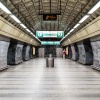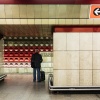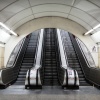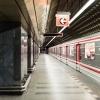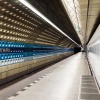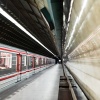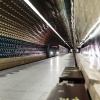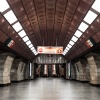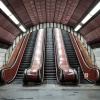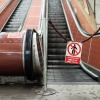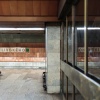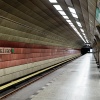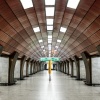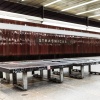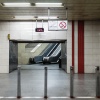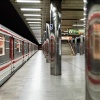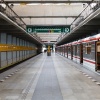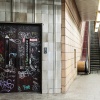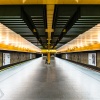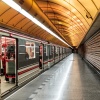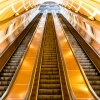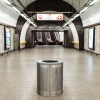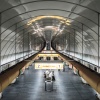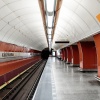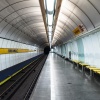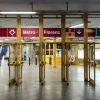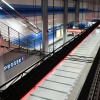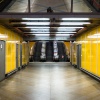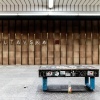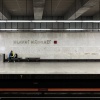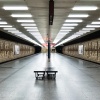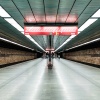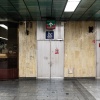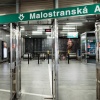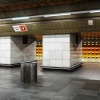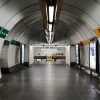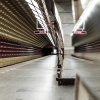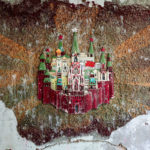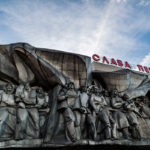Threesome – Prague’s Metro Network
If it’s rush hour in Prague and you miss a metro train by an inch only, then you merely have to wait 115-150 seconds until the next train pulls into the station. That’s top-notch in Europe, in particular in the background of only 1.2 million people living in Prague. The trains of Pražské Metro bomb along three lines through the underground of the Golden City, connecting old as well as brand-new stations that tell the modern history of the Czech capital.
Having had a look to Berlin or London the idea of an underground train system came up already back in 1898, but it took Prague’s Metro almost 70 years to become finally kicked off as the events of younger European history again and again postponed its constructions until January 7th, 1966, when Prague’s evening paper Vecerní Praha heralded proudly: “A historical moment for Prague’s transportation: The constructions of an underground tramway has begun. Today at 14 o’clock the first sod got turned for an underground.”
August 9th, 1967 meant a landmark for Prague’s metro as the construction works already done and finished actually aimed on an underground tramway system, while the Czechoslovakian decided to build a real underground together with the Soviets. Of course many technical as well as constructional changes followed that; Prague’s elders still remember those times of having a “pre-metro” and a “true metro” that’s running through the bowels of the Golden City, sometimes even at some 50 metres deep down.
It was the cooperation with the Soviets that had a massive impact on the Czech underground, constructional as well as optically. Andel station is a witness of that time as it reflects Muscovite metro architecture par excellence. Also the Soviet train type Ecs are remnants of that period. The oldest and “most” history-charged part of Prague’s metro is the section of red line C between stations Sokolovská (nowadays Florenc) and Kacerov.
The constructing engineers of Pražské Metro took their duty seriously and conserved the metro’s underground look and feel even when driving on the surface at daylight as the rails between Lužiny and Hurka stations lead through an entirely closed tube. That construction is part of the yellow line B, that is with 24 stations and a length of 25.6 kilometres the longest Prague metro line.
The red C line runs mostly only a few metres underneath the earth surface. Being the youngest among Prague’s underground rails the C stations have a non-Soviet appearance, meaning geometric and quadratic. All other stations, in particular the ones on the A line, are like Little Moscow: rails leading through roundish tubes deep down in the earth, framed by massive pillars being dressed with marble, granite, spaced-out glass bricks or copper sheet. One of those stations is Andel, where near Vltava River runs as small rivulet through the rail track’s bed.
Water, even flood water, that is the biggest problem for Prague’s metro. The red line C crosses below Vltava River even two times. It is no surprise that that section of the line got affected by the historic 2002 flood. For the yellow line that flooding even meant to be ~50% out of order as the Vltava-near rails between Radlická and Vysocanská stood idle. After that year ridership gained again and stabilised at about 550 million people being transported through the underground.
Only winners write the book of history, hence it didn’t take much time until the signs and termini of Communism got blotted out. For the metro that day has come on February 22nd, 1990 when stations got renamed from Leninova to Dejvická, Moskevska to Andel or Kosmonautu to Háje. As someone with the advantage of having eye-witnessed the Communist system such behaviour is pretty much strange as for example Ernst Thälmann has never done anything bad but fighting the Nazis, though his name-wise legacy got removed from East Berlin.
Despite being super busy places with plenty of people changing between Prague’s three underground lines, I had the chance to capture very short but almost abandoned appearing moments at the stations Muzeum, Mustek and Florenc. Latter station has its name from King Charles IV. who made Italians settle down at the same name district literally translated named “Florence”. Nowadays its home to the glass palaces built by Allianz, KPMG or Hilton.
Changing between the three lines at Prague’s big intersection points – on the corners of the triangle formed by Florenc, Mustek and Muzeum – is simple but sometimes involves longer walks through underground winding floors. Hence the picture of through and through baffled Asian or South European tourists understanding this system rather as Bermuda Triangle while stopping out of the blue amidst the crowd of rushing people inherently belongs to Prague’s Metro like the endlessly seeming escalators transporting passengers from daylight down to where transportation happens.
Besides the announcement inside the trains on lines A and B, Prague’s metro seems to be a man’s thing only as on all my rides through the underground I never saw a woman driving a train. The announcement I mean is “Please finish leaving and boarding the train as the doors are about to close.” spoken some 30 years ago by Svetlana Lavícková, who worked for Czech radio broadcasting. For Prague’s metro her message is a likewise trademark like “Mind the gap!” is for London. Sadly her voice got replaced on the trains of line C by a male speaker already.
The entire railway network stretches for 59.5 kilometres and has 57 stations, whereas line A will see a soon extension to the northwest to connect with Prague’s Letište Václava Havla Airport. In 1999 the yellow line’s station Rajská zahrada was awarded nationally as Construction of the Year. Its speciality is two platforms being built one above the other. The trains going out of town stop at ground level while the city-bound metro’s stop first floor.
Some of the most important station for visitors are Hlavní nádraží (central train station), Hradcanská (from where you can climb Pražský hrad, the castle hill) as well as Staromestská (the entrance to old town) and Mustek, being not far away from famous Wenceslas Square. The Czech capital decked out itself properly and all those places are an optical delight, though they are often crowded with hundreds of sightseers. Tourism, to Prague it’s both, a blessing as well as a curse.
This photo series was shot like all other underground images, meaning freehand and without tripod, solely using a prime lens at aperture 1.4 strictly while at each station only the time between two trains was available for taking photos. I started on a Saturday with trains on 7 minute interval at 7:30 and finished at 15:30, while line A got shot on a Sunday when trains were on a 10 minute interval.
